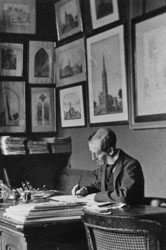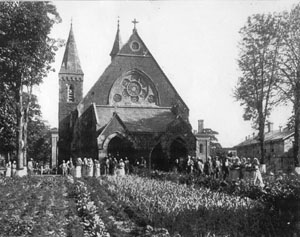The Chapel of the Good Shepherd, fully restored and recently rededicated, stands at the heart of the great new apartment complex built by the New York State Urban Development Corporation. Now attractively surrounded by a paved plaza, this late Victorian Gothic chapel is well integrated with its taller neighbors through the use of stone and brick in harmonizing colors, while at the same time it contrasts effectively with them both in scale and style. Designed by the prominent architect Frederick Clarke Withers, the chapel was begun in June, 1888 and completed the following year. It was the gift of New York banker George N. Bliss to the New York Protestant Episcopal Mission Society and was intended for use by the inmates of the Almshouse (later called the New York City Home for the Aged and Infirm).
The Almshouse was one of numerous charitable institutions maintained on the island by the City in the 19th century. In 1828, the City had purchased Blackwell’s Island, as it was then known, from the Blackwell family which had owned it for well over a century. The island was considered an ideal site for institutional development — as the Rev. J. F. Richmond wrote in his New York and its Institutions: the island, “separated on either side from the great world by a deep crystal current, appears to have been divinely arranged as a home for the unfortunate and the suffering, and a place of quiet reformatory meditation for the vicious.” During the course of the 19th century the City constructed a penitentiary, a workhouse, and many specialized hospitals.
Built in 1846, using stone quarried on the island and convict labor, the Almshouse originally consisted of only two buildings, separately housing men and women. However, by the 1890’s over a dozen buildings stood on its grounds, including the Chapel of the Good Shepherd, a Hospital for the Incurables, and the old Blackwell House, which was used as the residence of the Warden. The almshouse was capable of caring for about two thousand of the City’s poor, and the chapel itself had a seating capacity of four hundred. It also had a large reading room, a robing room for the clergy, and a room for the use of the Mission Society workers in the basement.
The general character of the use made of the island was reflected in its official renaming as Welfare Island in 1921. During the 20th century many of the institutional buildings on the island became inadequate and obsolete. Goldwater Memorial Hospital, the first modern hospital on the island, was opened in July 1939, and in the 1950s the old Metropolitan and City Hospitals on Welfare Island were relocated in new buildings in Manhattan and in Queens. The large Bird S. Coler Hospital and Home opened in 1952, replacing the function of the City Home which was subsequently closed. Ferry service to the island was discontinued in 1956 and the Chapel closed its door in 1958.
Redevelopment plans for Welfare Island — renamed Franklin Delano Roosevelt Island in 1973 — under the direction of the New York State Urban Development Corporation were begun in the late 1960s, and a survey of the existing structures was undertaken. On the basis of recommendations made by the New York City Landmarks Preservation Commission and a report prepared by noted architectural historian Henry-Russell Hitchcock, the Chapel of the Good Shepherd and several other buildings were included in a list of structures especially worthy of preservation. New York architect, Giorgio Cavaglieri, who earlier had adapted the old Astor Library to a new use as the Shakespeare Festival Theater and the Jefferson Market Courthouse to a library, carried out the handsome restoration of the chapel, which was reopened in October of 1975.
 The chapel is a large one, reminiscent in style of English parish churches. Indeed, the architect, Frederick Clarke Withers (1828-1901, pictured to the left), was an Englishman trained in Great Britain, who came to the United States in 1852 at the invitation of the renowned American landscape architect, Andrew Jackson Downing. Unfortunately, Downing drowned that same year following the explosion of the steamboat Henry Clay. Withers then turned to Calvert Vaux, Downing’s former partner with whom he became associated. In 1857, Withers was one of the first to be asked to join the newly founded American Institute of Architects. Although he always retained his British citizenship, he volunteered for service in the Union Army in 1861. He returned home an invalid the following year, but recovered, and resumed practice in New York City, joining Vaux along with Frederick Law Olmstead in a partnership that lasted until 1871. He continued to practice architecture, and in 1888 formed a partnership with Walter Dickson. Together as supervising architects for the Board of Charities and Correction they designed several buildings on Roosevelt Island among them the Strecker Memorial Laboratory and three brick structures for the Almshouse. In 1897, Withers retired to his home in Yonkers, New York.
The chapel is a large one, reminiscent in style of English parish churches. Indeed, the architect, Frederick Clarke Withers (1828-1901, pictured to the left), was an Englishman trained in Great Britain, who came to the United States in 1852 at the invitation of the renowned American landscape architect, Andrew Jackson Downing. Unfortunately, Downing drowned that same year following the explosion of the steamboat Henry Clay. Withers then turned to Calvert Vaux, Downing’s former partner with whom he became associated. In 1857, Withers was one of the first to be asked to join the newly founded American Institute of Architects. Although he always retained his British citizenship, he volunteered for service in the Union Army in 1861. He returned home an invalid the following year, but recovered, and resumed practice in New York City, joining Vaux along with Frederick Law Olmstead in a partnership that lasted until 1871. He continued to practice architecture, and in 1888 formed a partnership with Walter Dickson. Together as supervising architects for the Board of Charities and Correction they designed several buildings on Roosevelt Island among them the Strecker Memorial Laboratory and three brick structures for the Almshouse. In 1897, Withers retired to his home in Yonkers, New York.
While the High Victorian Gothic Jefferson Market Courthouse, located in the Greenwich Village Historic District, is the best known of Wither’s New York City works, he had many other New York commissions, among them the commercial building at 448 Broome Street in the SoHo-Cast Iron Historic District, the high altar and reredos in Trinity Church, the lich gate of the “Little Church Around the Corner” (Church of the Transfiguration), and the City Prison which replaced the original “Tombs.” Withers was primarily considered an ecclesiastical architect and published the influential book Church Architecture in 1873. He was a strong advocate of the Gothic style for churches, and the Chapel of the Good Shepherd admirably illustrates his conceptions and ideas of what a church should be.
In his book, Withers recommends the combining of different building materials for picturesque effect. The exterior of the chapel, constructed in a number of materials is richly textured and subtly polychromatic. The warm red brick of the walls, laid in a modified version of Flemish bond, is enlivened by the random interspersing of gray brick. Smooth brownstone windows and door enframements, quoins and ornamental detail contrast effectively with both the brick and rough-faced gray stone of the basement story. This gray stone, used for many of the institutional buildings on the island, is the “granite” (actually gray gneiss) which was quarried on the island since the 18th century.
 The plan and massing of the chapel are simple and clear. Two projecting entrance porches, flanked by lampposts, lead to two ascending stairways within the deep narthex. Originally, one entrance was intended for the men of the Almshouse, the other for women. The stairways give access to a broad and spacious nave, five bays in depth, which terminates in the chancel and semicircular apse. The bell tower features a broach spire, a type which was especially favored by Withers. It provides a strong and effective note of asymmetry. The bell of the tower, now displayed in the plaza, is five toned, since Withers found single toned bells “doleful and monotonous.” The harmonizing red brick plaza surrounding the chapel and was designed by the architectural firm Johansen & Bhavnani. It provides a delightfully restful oasis enframed by tall apartment buildings. The architects carefully retained the old trees to the west of the church and provided benches on three sides.
The plan and massing of the chapel are simple and clear. Two projecting entrance porches, flanked by lampposts, lead to two ascending stairways within the deep narthex. Originally, one entrance was intended for the men of the Almshouse, the other for women. The stairways give access to a broad and spacious nave, five bays in depth, which terminates in the chancel and semicircular apse. The bell tower features a broach spire, a type which was especially favored by Withers. It provides a strong and effective note of asymmetry. The bell of the tower, now displayed in the plaza, is five toned, since Withers found single toned bells “doleful and monotonous.” The harmonizing red brick plaza surrounding the chapel and was designed by the architectural firm Johansen & Bhavnani. It provides a delightfully restful oasis enframed by tall apartment buildings. The architects carefully retained the old trees to the west of the church and provided benches on three sides.
The decorative detail of the chapel is used sparingly but with sensitivity. The paired Gothic lancet windows between the buttresses on the flanks of the building are crowned by simple connecting drip moldings with foliate terminations. The large Gothic rose window of the entrance facade is set within a brownstone pointed arch enframement decorated with carved roundels. A third roundel appears near the apex of the gable. The original handsome stained-glass windows have geometric patterns except in the five windows of the apse which depict the four Evangelists, surrounding Christ, the Good Shepherd.
The relative austerity of the design of the chapel was probably considered the most suitable for a poorhouse chapel. Withers created a building of imposing simplicity and restraint which is both appropriate and picturesquely handsome.
The chapel was commissioned by George M. Bliss (1816-1896), an important New York banker, who began his career in the dry goods business. Through successful speculation during the Civil War, he amassed a large fortune, and in 1869 he joined Levi P. Moron, later a Vice-President of the United States, in a banking business under the firm name of Morton, Bliss & Company. In his later years he served as Treasurer of the Protestant Episcopal Mission Society which administered the Chapel of the Good Shepherd.
Today the chapel serves a new and more general purpose, as a community center for the residents of the island’s new housing complex. It has also been rededicated to serve as an ecumenical place of worship.
